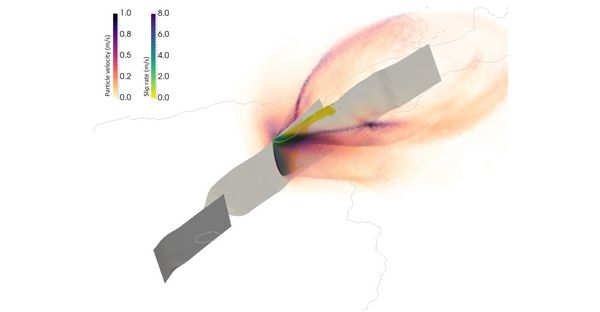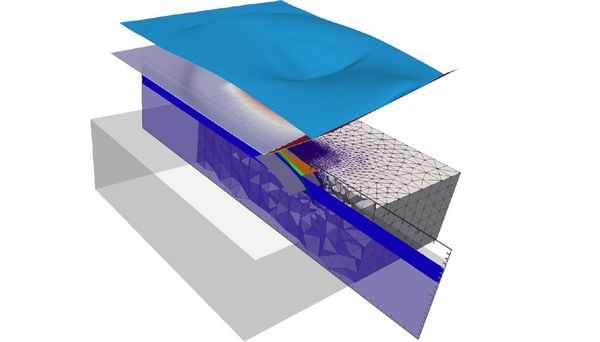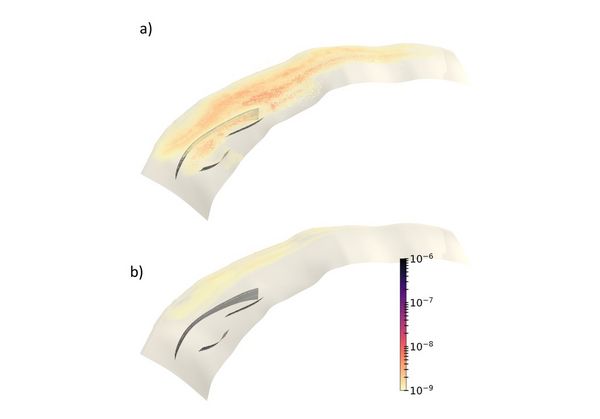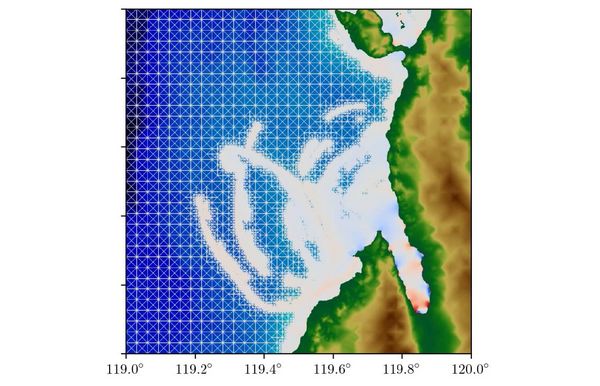ENVIRONMENT AND ENERGY
Advanced Simulation of Coupled Earthquake-Tsunami Events
Principal Investigator:
Michael Bader(1), Alice-Agnes Gabriel(2)
Affiliation:
(1)Technical University of Munich, (2)Ludwig-Maximilians-Universität München
Local Project ID:
pr45fi
HPC Platform used:
SuperMUC and SuperMUC-NG of LRZ
Date published:
Introduction
In the framework of the ASCETE (Advanced Simulation of Coupled Earthquake and Tsunami Events) project, the computational seismology group of LMU Munich and the high performance computing group of TUM jointly used the SuperMUC HPC infrastructures for running large-scale modeling of earthquake rupture dynamics and tsunami propagation and inundation, to gain insight into earthquake physics and to better understand the fundamental conditions of tsunami generation. The project merges a variety of methods and topics, of which we highlight selected results and impacts in the following sections.
Results and Methods
We link physics-based models of subduction zone geodynamics and seismic cycling, three-dimensional dynamic earthquake rupture, and tsunami generation, propagation, and inundation (Figure 1, [1]).
A long term subduction zone geodynamics and seismic cycling model is used to constrain the initial conditions of 3D dynamic earthquake rupture models. These conditions include the lithology, stress field, fault geometry, and fault strength, which are physically consistent with one another due to their development together over many slip events in the subduction scenario. 3D dynamic rupture simulations are then run and the time-dependent seafloor displacements are used to dynamically source a potential tsunami. Such linked models allow evaluating the effects of certain earthquake characteristics on tsunami behavior. These methods facilitate research into the physical relationships between processes operating across the spatial and temporal time scales of long-term deformation, earthquake rupture, and tsunami propagation.
In the model pipeline, three-dimensional dynamic rupture simulations pose an extreme computational challenge and require extensive supercomputing resources. In order to make these computationally feasible, we heavily optimised the software package SeisSol during the course of this project. These optimizations include a new cache aware wave propagation scheme, optimizations of the dynamic rupture kernels using code generation, a novel clustered localtimestepping scheme for dynamic rupture and the development of asynchronous outputs to overlap I/O and compute time.
Our largest model of the 2004 Sumatra-Andaman earthquake ran on the full SuperMUC Phase 2 for 14 h [3]. Our simulation, featuring an unstructured tetrahedral mesh of 221 million elements and sixth-order accuracy in space and time, solves a discretized PDE system of 111 billion degrees of freedom. This allows the earthquake dynamics to be properly resolved as well as the wavefield up to 2 Hz in the surrounding media.
In follow-up studies of the 2004 Sumatra-Andaman earthquake, we focused on the controlling mechanisms of the event kinematics and dynamics, using new dynamic rupture scenarios and tsunami simulations. Our new scenarios suggest that along-depth variation of trench sediments, including off-fault plastic yielding [4], as well as along-arc variations of regional stresses and tectonic convergence rates are the dominant factors controlling the event’s dynamics and kinematics. Depending on the intensity of the plastic wedge failure (Figure 2), the earthquake may have produced a narrow band of shallow and large slip. This would have translated into localized high ground displacement, invisible to tele-seismic and near-field geodetic measurements, but able to modulate locally the tsunami.
We applied combined earthquake-tsunami modeling to the MW 7.5 Palu earthquake, which occurred on September 28th, 2018, ruptured a 180 km long section of the Palu-Koro strikeslip fault system, in Sulawesi, Indonesia. The earthquake ruptured predominantly southward and beneath Palu Bay, a narrow inlet with a length of 30 km, until it stopped after a total rupture time of 30–40 s. The Palu earthquake triggered a local but powerful tsunami that devastated the coastal area of the Palu Bay quickly after the earthquake, characterized locally by inundation depths of over 6 m and run-up heights of over 9 m. Devastating tsunamis associated with submarine strikeslip earth quakes are rare. In fact, their associated ground displacements, predominantly horizontal, not vertical, do not favor tsunami genesis.
Using combined earthquake and tsunami models of the 2018 Sulawesi event (Figure 3), we were able to identify the drivers of the deadly tsunami in Palu last year. The key finding is that mean vertical offset beneath Palu Bay of 1.5 m is directly caused by the earthquake, generating a tsunami that matches field observations without any contribution from landsliding. These findings may lead to rethinking tsunami hazard in other regions worldwide, where similar fault systems cross beneath narrow Gulfs, such as the elongated Bodega and Tomales bays in northern California, USA, which host major segments of the San Andreas fault system.

Figure 3: Dynamic rupture multiphysics scenario of the 2018 MW 7.5 Palu earthquake and tsunami. Top: Snapshot of the wavefield (absolute particle velocity in m/s) across the fault network and of the fault slip rate after 15 seconds of simulation time. A shear Mach front, caused by the supershear rupture, is clearly visible (from [2]).
Ongoing Research / Outlook
There remain unresolved questions in the (uni-directional) coupling of physical models used in ASCETE. E.g., how does one filter out fast waves travelling along the ocean bottom which cannot be represented by the tsunami model? Or how shall sharp gradients in the bathymetry be handled? In order to answer such questions, we plan to implement fully coupled earthquake-tsunami models in which the ocean is modeled as an acoustic layer with a gravitational boundary condition on top of the solid domain of an earthquake.
References and Links
[1] E. Madden et al., Geophys. J. Int., 224.1, pp. 487516 (2021). doi.org/10.1093/gji/ggaa484
[2] Ulrich, T. et al., Pure Appl. Geophys., 176.10, pp. 4069–4109 (2019). http://dx.doi.org/10.31223/osf.io/3bwqa
[3] Uphoff, C. et al. (2017). “Extreme Scale Multiphysics Simulations of the Tsunamigenic 2004 Sumatra Megathrust Earthquake”. In: Proceedings of the International Supercomputing Conference SC ’17. Denver, Colorado: ACM, 21:1–21:16. https://doi.org/10.1145/3126908.3126948
[4] S. Wollherr, A. Gabriel, C. Uphoff, Geophys. J. Int., 214.3, pp. 1556–1584 (2018). http://dx.doi.org/10.1093/gji/ggy213
Research Team
Michael Bader (PI)1, Ravil Dorozhinskii1, Alice-Agnes Gabriel (PI)2, Lukas Krenz1, Elizabeth Madden2, Leonhard Rannabauer1, Sebastian Rettenberger1, Thomas Ulrich2, Carsten Uphoff2, Sebastian Wolf2, Stephanie Wollherr2
Project Partners: Universität Hamburg and Eidgenössische Technische Hochschule Zürich (ETH) Zurich
Scientific Contacts
Prof. Dr. Michael Bader
Technical University of Munich (TUM)
Chair of Scientific Computing in Computer Science (SCCS) of TUM’s informatics department
Boltzmannstr. 3, D-85748 Garching (Germany)
e-mail: bader [at] in.tum.de
https://www.in.tum.de/i05/bader/
Prof. Dr. Alice-Agnes Gabriel
Ludwig-Maximilians-Universität München (LMU)
Department of Earth and Environmental Sciences, Geophysics
Theresienstr. 41, D-80333 Munich (Germany)
e-mail: alice-agnes.gabriel [at] geophysik.uni-muenchen.de
NOTE: This report was first published in the book "High Performance Computing in Science and Engineering – Garching/Munich 2020 (2021)" (ISBN 978-3-9816675-4-7)
Local project ID: pr45fi
September 2021


